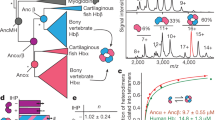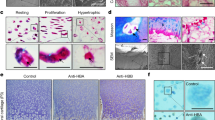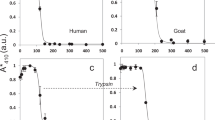Abstract
THE formation of a circulatory system in the ontogeny of mammals coincides with the appearance of nucleated erythroid cells which are produced in the blood islands of the yolk sac. These cells contain specific embryonic haemoglobins (Hbs) which probably transport oxygen during the earliest stages of mammalian development. Such embryonic Hbs have been demonstrated in man1–5 and several other mammalian species6–8. Structural investigations of these pigments showed them to be tetramers which contain unique α-type or β-type subunits. It was also shown that the embryonic α-type subunits of man, mouse and rabbit have more sequence similarity among each other than between the embryonic and the adult α subunit of the same species, indicating that the divergence of embryonic and adult α subunits is much older than mammalian evolution8.
This is a preview of subscription content, access via your institution
Access options
Subscribe to this journal
Receive 51 print issues and online access
$199.00 per year
only $3.90 per issue
Buy this article
- Purchase on Springer Link
- Instant access to full article PDF
Prices may be subject to local taxes which are calculated during checkout
Similar content being viewed by others
References
Huehns, E. R., et al., Nature, 201, 1095–1097 (1964).
Hecht, F., Motulsky, A. G., Lemire, R. J., and Shepard, F. E., Science, 152, 91–92 (1965).
Kaltsoya, A., Fessas, P., and Stavropoulos, A., Science, 153, 1417–1418 (1966).
Szelényi, J. G., and Hollán, S. R., Acta biochem. biophys. Acad. Sci. Hung., 4, 47–55 (1969).
Capp, G. L., Rigas, D. A., and Jones, R. T., Nature, 228, 278–280 (1970).
Fantoni, A., Bank, A., and Marks, P. A., Science, 157, 1327–1329 (1967).
Kleihauer, E., and Stöffler, G., Molec. gen. Genet., 101, 59–69 (1968).
Melderis, H., Steinheider, G., and Ostertag, W., Nature, 250, 774–776 (1974).
Farooqui, A. M., and Huehns, E. R., in Sixth int. Symp. Struktur u. Funktion d. Erythrocyten, 1970 (edit. by Rapoport, S. M., and Jung, F.), 217–220 (Akademie Berlin, 1972).
Tuchinda, S., Nagai, K., and Lehmann, H., FEBS Lett., 49, 390–391 (1975).
Fantoni, A., de la Chapelle, A., and Marks, P. A., J. biol. Chem., 224, 675–681 (1969).
Gilman, J. G., and Smithies, O., Science, 160, 885–886 (1968).
Niesel, W., and Thews, G., Pflügers Arch., 273, 380–395 (1961).
Sick, H., and Gersonde, K., Analyt. Biochem., 32, 362–376 (1969).
Hill, A. V., J. Physiol., Lond., 40, 4–7 (1910).
Kilmartin, J. V., and Rossi-Bernardi, L., Nature, 222, 1234–1246 (1969).
Goodman, M., Moore, W., and Matsuba, G., Nature, 253, 603–608 (1975).
Krimsky, I., in Methoden der enzymatischen Analyse (edit. by Bergmeyer, H., 238–240 (Chemie, Weinheim/Bergstrasse, 1962).
Author information
Authors and Affiliations
Rights and permissions
About this article
Cite this article
BAUER, C., TAMM, R., PETSCHOW, D. et al. Oxygen affinity and allosteric, effects of embryonic mouse haemoglobins. Nature 257, 333–334 (1975). https://doi.org/10.1038/257333a0
Received:
Accepted:
Published:
Issue Date:
DOI: https://doi.org/10.1038/257333a0
This article is cited by
-
Convergent evolution of hemoglobin switching in jawed and jawless vertebrates
BMC Evolutionary Biology (2016)
-
Ontogeny of globin expression in zebrafish (Danio rerio)
Journal of Comparative Physiology B (2011)
-
Intraerythrocytic organic phosphates of fetal and adult seaperch (Embiotoca lateralis): Their role in maternal-fetal oxygen transport
Journal Of Comparative Physiology B (1981)
-
Haemoglobin-oxygen affinity in developing embryonic erythroid cells of the mouse
Journal of Comparative Physiology ? B (1979)
-
Embryonic hemoglobins: dependency of functional characteristics on tetramer composition
Pfl�gers Archiv European Journal of Physiology (1978)
Comments
By submitting a comment you agree to abide by our Terms and Community Guidelines. If you find something abusive or that does not comply with our terms or guidelines please flag it as inappropriate.



